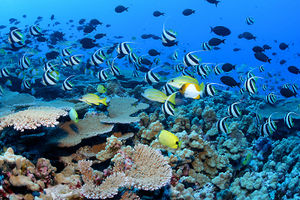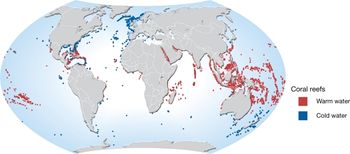Coral reefs
This article describes the habitat of the coral reefs. It is one of the sub-categories within the section dealing with biodiversity of marine habitats and ecosystems. It gives an overview of the formation, distribution, biology, zonation, requirements for development, biota and threats.
Introduction
Coral reefs are one of the most diverse ecosystems in the world. The organisms are part of the group Cnidaria. The most known type of corals is the one in the clear, warm tropical water with plenty of colorful fishes. This is a stony, shallow water type. The clear water is because of the low concentrations of nutrients. But there are also deep water corals that live in dark cold waters and soft corals that live in shallow, cold waters. They are organically constructed, wave resistant rock structures created by carbonate-secreting animals and plants.

Formations
The formation begins when free-swimming coral larvae attach to submerged rocks or other hard substrates along the edges of islands or continents. The reef expands and will form an atoll, barrier or fringing. These 3 are the main reef types. Atolls are circular or oval coral reefs that encircle a lagoon partially or completely. A barrier reef is a reef that borders the shoreline over a long distance. They are separated from the adjacent land mass by a lagoon. Further, a fringing reef forms borders along the shoreline and the surrounding islands, but at smaller distance than barrier reefs. It is directly attached to the land. This is the most common type of coral reefs. [2] Other special reef arrangements are apron, patch, ribbon, table and bank reefs. Apron reefs are very similar to fringing reefs. They are more gently sloping and extending downward from the land margin. Patch reefs are isolated and often circular. They surround a lagoon or embayment. Ribbon reefs are small and long and are connected to an atoll lagoon. Table reefs are future atolls, but are not yet connected to a lagoon. At last, bank reefs are similar to the patch, but are larger and often hemispherical. [3]
Coral reefs are also one of the oldest habitats in the ocean. They have slow growth rates so it can take up to 10,000 years for a coral reef to form from a group of larvae. [4] The different types all share similarities in their biogeographic profiles. Horizontal and vertical '''zonation''' is created by bottom topography, depth, wave and current strength, light, temperature and suspended sediments.
Distribution
The warm water corals are distributed in the tropics. They are found in areas where the water is more than 18°C and where the water is clear. The maximum average depth is 60 meters, but other types can be found deeper. They are generally found within the 30°N and 30°S. Various species are found in all oceans of the world, from the tropics to the polar regions. Cold water corals have been found in places as Antartica, Australia, Canada, Ecuador, Japan, New Zealand, Norway, United Kingdom, Europe and the United States.

Biology
The principal reef-building organisms are hard coral (scleractinian corals). The formation starts with a planula larva that settles down and attaches itself to a hard substrate. Then the larva develops into a coral polyp and secretes calcium carbonate around its body. The reproduction is by budding, an asexual process. As the asexual reproduction continues, the colony grows. Each polyp is covered by a thin tissue and can be quite colorful. Some polyps in the colony develop gonads and are able to reproduce sexually. These polyps release sperm and eggs in the surrounding water so fertilization occurs. The cells have protein molecules on their surfaces that identify the kind of species. [8]
The coral itself consists of a sac-like polyp that is protected by a rigid calcium-carbonate exoskeleton. This is called a corallite. The bottom of this corallite is divided into vertical segments or septa. At the top, the polyp has an opening that is a combined mouth and anus. This leads to the gut. The opening is surrounded by tentacles with mucus secreting cells for catching prey. In the outer layer of the coral’s flesh, modified dinoflagellates or zooxanthellae are imbedded in it. This causes a stable environment for them. The cells are abundant and can represent up to 75% of the tissue weight. The zooxanthellae and the polyps are associated in a biological symbiontic interaction called mutualism. The zooxanthellae require sunlight for photosynthesis. They provide nutrients to the polyps and reduce the level of carbon dioxide. This makes the conditions to form skeletons more suitable. In turn, the zooxanthellae get a suitable habitat. The type of corals with zooxanthellae is called hermatypic.
Not all corals are reef building species. There are also some species of hard corals existing as single, solitary polyps. Other temperate species form small colonies only. Corals that lack the hard outer coverings of calcium carbonate are soft corals. Cold water corals lack the symbiontic algae. This type with no zoooxanthellae is called ahermatypic.
Zonation

On the seaward side, the reef rises from the lower depths of the ocean to a level just at or just below the surface of the water. This is called the reef front or fore-reef. The slope of this area can be either gentle or steep. It sometimes forms a vertical wall known as a dropoff. But generally, the reef front forms finger-like arrangements called spur and groove formation. It distributes the wave energy and prevents damage to the reef and its inhabitants. The grooves are sand-filled pockets and allow sediments to be channeled down and away from the coral surface. In this way, it provides a habitat for many species of burrowing organisms. The reef crest is the highest point of the reef. More landward, the reef flat or back reef is formed. This area has a high degree of variability. The bottom of the reef flat consists of rock, sand, coral cobble or combinations of these. Seagrasses are commonly found in this area. The reef ends at the shoreline or descends into the lagoon.
The different areas support different species of corals and organisms. On the reef front, dome-shaped, massive brain corals (Diploria) and columnar pillar corals (Dendrogyra) are found. Below this region, platelike species such as Pectinia, Pavona and Agaricia are found. Higher upon the reef, branched species of coral are found. This is because of the wave stress. A coral that occurs in the region is elkhorn coral (Acropora palmata). Behind the reef front, more protected areas are occupied with more delicate species such as staghorn coral (Acropora cervicornis), finger (Stylophora), cluster (Pocillophora) and lace corals (Pocillophora damicornis). In shallow, calmer waters away from the reef front, small species such as rose (Meandrina, Manicina), flower (Mussa, Eusmilia) and star (Montastraea) corals are found.
References
- ↑ http://en.wikipedia.org/wiki/Coral_reef
- ↑ NOAA National Ocean Service Education: Corals
- ↑ http://www.coral-reefs.org
- ↑ Barnes R.D. 1987. Invertebrate Zoology. Fifth edition. Fort Worth, TX. Harcourt Brace Jovanovich College Publishers. 92-96, 127-134, 149-162.
- ↑ 5.0 5.1 5.2 5.3 http://www.coral-reefs.org
- ↑ http://antigreen.blogspot.com/2006_09_01_archive.html
- ↑ http://maps.grida.no/go/graphic/distribution-of-coldwater-and-tropical-coral-reefs - UNEP/GRID-Arendal - Hugo Ahlenius
- ↑ Karleskint G. 1998. Introduction to marine biology. Harcourt Brace College Publishers. p.378
- ↑ http://www.reef.crc.org.au/publications/brochures/Biologybleaching.htm - Michael ten Lohuis
- ↑ NOAA
- ↑

Please note that others may also have edited the contents of this article.
|







